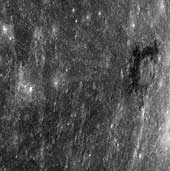|
COMETS EARTH JUPITER KUIPER BELT MARS MERCURY METEORITES NEPTUNE OORT CLOUD PLUTO SATURN SOLAR SYSTEM SPACE SUN URANUS VENUS ORDER PRINTS
PHOTO CATEGORIES SCIENCEVIEWS AMERICAN INDIAN AMPHIBIANS BIRDS BUGS FINE ART FOSSILS THE ISLANDS HISTORICAL PHOTOS MAMMALS OTHER PARKS PLANTS RELIGIOUS REPTILES SCIENCEVIEWS PRINTS
|
Related Documents
Download Options
Date Acquired: October 6, 2008 A crater discovered in the newly imaged portion of Mercury's surface during MESSENGER's second Mercury flyby has uncommonly dark material within and surrounding the crater. The material is darker than the neighboring terrain such that this crater with a diameter of 180 kilometers (110 miles) is easily identified even in a distant global image of Mercury; it is located just south of the equator near the limb of the planet in this previously released Wide Angle Camera (WAC) image. The dark halo may be material with a mineralogical composition different from the majority of Mercury's visible surface. Craters with similar dark material on or near their rims were seen on the floor of the Caloris basin during MESSENGER's first flyby. Images acquired though the 11 different narrow-band color filters of the WAC during MESSENGER's second flyby will be crucial to an understanding of the nature of this newly seen, unusual feature. Credit: NASA/Johns Hopkins University Applied Physics Laboratory/Carnegie Institution of Washington |
